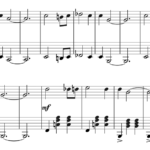The Sound of Nostalgia: Nino Rota’s “Godfather Waltz”
By Rebekah Gonzalez
Nino Rota once said, about his work as a composer, “They reckon my music’s just a bit of nostalgia plus lots of good humor and optimism? Well, that’s exactly how I’d like to be remembered.”
It is ironic, then, that his best-known work is the score to The Godfather—a film that, on the surface, offers violence and loss rather than “good humor and optimism.” Yet Rota’s Godfather score draws out aspects of the film that lie beneath the surface— its dark humor and its nostalgia —and helps give the film’s nostalgia its emotional pull and complexity. As a period film, its story set in the mid-1940s, though filmed through the scope of a 1970s camera, The Godfather cannot help but become subject to the yearning for a time before. That general nostalgia is amplified through another more specific nostalgia found within the film—the nostalgia that gives a charge to Vito and Michael Corleone’s relationship. This type of nostalgia is concerned with the future, but a future that has been tenuously predetermined.
It’s as if “The Godfather Waltz” says, “I never wanted this for you, Michael,” before Vito Corleone himself can say it.
Rota, we’ll see, translates the nostalgia of the father-son relationship into the music of the Main Title or “The Godfather Waltz.” Rota focuses on the dualities of the relationship. While the song serves as a roadmap for Michael’s future, it simultaneously explores Vito’s struggle with granting the reins of his deadly business to his son. The film seems to be cognizant of what the future holds, but while Coppola makes the audience, as well as the characters in the film, work towards this ending, Rota surreptitiously clues them in through his Main Title. It’s as if the “Godfather Waltz” says, “I never wanted this for you, Michael,” before Vito Corleone himself can say it.
***
(Nino Rota, “The Godfather Waltz,” from the soundtrack to The Godfather)
The film opens with a black screen, making the viewer’s first engagement with the film a purely auditory one. The trumpet plays the main melodic line of the waltz as the title of the movie appears and fades from the screen. After it plays through it once, Bonasera’s monologue begins. The only two characters on screen are Bonasera and Vito Corleone. It is clear that Vito is in a position of power. This is the first time the trumpet is attached to a scene with Vito. However, the connection is not made clear until the next time we hear the trumpet line at 46:05, when Vito is shot. As the dying Vito slides off his car and onto the ground, the melody is played at a higher key, making the powerful line of music sound frail.
At this point, it is clear that the trumpet is meant to represent Vito. It is never played when Vito is not somewhere in the shot. Directly after, the film dissolves into a shot of Radio City Music Hall, where Michael and Kay are leaving after watching a show. Although the trumpet fades away before Michael is on screen, this placement of the theme puts Michael in close proximity to his father’s haunting song. It also important to note that this is the last time we see Michael living a carefree and “normal” life; one not centered around the family business.
When Rota has the main melody played by oboe, not the trumpet we associate with Vito, he foreshadows how the role of Don will be passed onto Michael
The waltz is next used is at 58:08, and for the first time we hear past the trumpet solo. The trumpet solo is skipped and Rota instead uses an oboe to play the main melody. This choice solidifies the sense that the trumpet represents Vito, who has been sidelined by the hit on his life: the instrument that stood for him has gone quiet, and now other instruments must take up his theme. There is another dissolve into a shot of Michael; he is sitting outside looking down at his shoes. This time, instead of the trumpet solo fading out, the music continues into the traditional waltz portion of the piece: we sense, through the playing of theme, how the future of Vito’s business and legacy hangs over Michael’s head. During this particular moment of the waltz, the main melody has moved, once again, to the oboe. This orchestration foreshadows how the role of Don will be passed onto Michael, even though none of the characters expect it at this point in the film.
***
While Michael is hiding out in Sicily, the Waltz does not follow him there, which is surprising given its folkloric elements. At 1:20 on the soundtrack version of the “Godfather Waltz,” Rota has an accordion play a couple of bars of the main melody before switching back to the oboe. The use of the accordion can directly be associated with Italian folk music. This moment in the score foreshadows Michael’s stay in Sicily. It would seem logical, then, that this specific moment in the piece would be used in tandem with the scene that it is derived from. However, its absence speaks to the physical separation between Michael and Vito, and roots the Waltz to the specific nostalgia found in their father-son relationship. Vito is upset when he learns that Michael has committed murders in the name of the family business.
We might say that, just as the film uses its geographical locations to show that they are physically separated, Rota’s score— specifically the fact that the “Godfather Waltz” is not played—expresses that the two are also emotionally separated at this point in the film. More generally, we might observe that, despite being the main theme of the film, the “Godfather Waltz” is used strikingly sparely across the film. This scarce use of the theme aligns with the scarce number of scenes that Michael and Vito share alone. Because these scenes are rare, they also become packed with meaning and purpose.
It is also important to note that the waltz is never used during a scene in which Michael and Vito are alone. Rather, the waltz is placed in between scenes that transition from Vito to Michael. It is used to link their two characters as well as to dramatize the tension between the two of them while Michael is on his way to becoming the Don. The tension is not personal, but it does affect their relationship. There seems to be a barrier, which derives partly from Vito’s pride and partly from their lack of alone time, which keeps Vito from speaking directly with Michael.
Through the waltz, Rota is able to verbalize, through the melancholic minor mode of the theme’s melody, what Vito struggles to tell Michael. The Waltz formulates Vito’s emotions throughout the film until he can say them himself, in a scene that Coppola added during filming because he felt that the two of them—and the film itself—needed this moment of emotional connection. It is not until we are over two hours into the film that Vito tells Michael that he once pictured his son as “Senator Corleone, Governor Corleone,” and confesses that “I never wanted this for you.”
***
The “Godfather Waltz” is not heard again until the film’s closing scene. Although it is not technically considered the “Godfather Waltz,” the Finale draws upon the same waltz structure as well as the melody. The trumpet—lonely no more—blends with the rest of the orchestra as Michael’s hand is kissed and as he’s called, for the first time, “Don Corleone”; the swell of the music underlines that he has fully transitioned into his father’s position of power. The return of the trumpet also suggests that the trumpet was never associated with Vito himself, but rather with Vito as the Don. This, along with the cyclical structure of the waltz, alludes to the possibility that the family’s power might revive itself in this way again and again. Looking toward the past while announcing an eminent future, Rota’s “Godfather Waltz” establishes the particular nature of the Corleone family’s power: rooted in a never-ending nostalgia, and ever-seeking renewal.


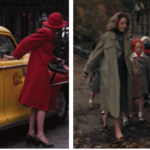

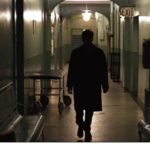

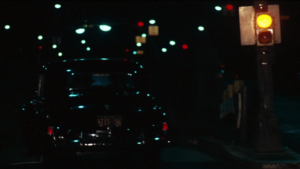 The transition to the scene establishes an atmosphere of tension. Two unidentified men drive Michael into the city to meet Kay at the hotel. The camera jump-cuts from a shot of Michael in the backseat to the car’s bumper. We watch the car pass a flashing yellow streetlight on its right side. It is nighttime, the road is clear, and the only sound effects we hear are the tires hissing against the asphalt. This shot lasts only twelve seconds but establishes a sequence and tone. The direct sound of the tires seems menacing and heightens the peril of events so far—Vito Corleone’s attack, Paulie Gatto’s assassination.
The transition to the scene establishes an atmosphere of tension. Two unidentified men drive Michael into the city to meet Kay at the hotel. The camera jump-cuts from a shot of Michael in the backseat to the car’s bumper. We watch the car pass a flashing yellow streetlight on its right side. It is nighttime, the road is clear, and the only sound effects we hear are the tires hissing against the asphalt. This shot lasts only twelve seconds but establishes a sequence and tone. The direct sound of the tires seems menacing and heightens the peril of events so far—Vito Corleone’s attack, Paulie Gatto’s assassination.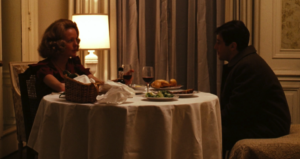 A slow dissolve transitions us into the hotel room and is joined with a sound bridge, Irving Berlin’s “All My Life.” This song—a slow-tempo ballad often performed by a female vocalist addressing her lover—presents a surprising counterpoint to the preceding events, easing us into the scene and suggesting an emotional uplift in the narrative. It overlaps with the dialogue and is part of the film’s diegesis: the song seems to play somewhere in the background. The music is muted and subtle, softly complementing the dinner’s romantic atmosphere—a small round table and white tablecloth; red wine and steak; Kay’s lipstick-red blouse with a sweetheart neckline and puffed sleeves, Michael’s oxford shirt and tie. A lamp in the corner provides diffused light that illuminates Kay’s face. Her cheeks look cherubic; her skin, soft and warm.
A slow dissolve transitions us into the hotel room and is joined with a sound bridge, Irving Berlin’s “All My Life.” This song—a slow-tempo ballad often performed by a female vocalist addressing her lover—presents a surprising counterpoint to the preceding events, easing us into the scene and suggesting an emotional uplift in the narrative. It overlaps with the dialogue and is part of the film’s diegesis: the song seems to play somewhere in the background. The music is muted and subtle, softly complementing the dinner’s romantic atmosphere—a small round table and white tablecloth; red wine and steak; Kay’s lipstick-red blouse with a sweetheart neckline and puffed sleeves, Michael’s oxford shirt and tie. A lamp in the corner provides diffused light that illuminates Kay’s face. Her cheeks look cherubic; her skin, soft and warm.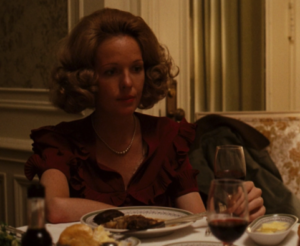
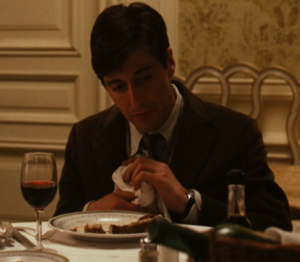 The halting rhythm of the camera draws out the scene’s feeling of awkwardness. The scene’s establishing shot shows Kay sitting at the dinner table. The camera frames her using a point-of-view vantage and positions us in a medium close-up. Immediately we notice her red blouse, princess-length pearl necklace, coiffed hair, and hesitant face. Kay appears vulnerable, and since that vulnerability charges the establishing shot, we know it will inform the scene. The camera transitions to Michael wadding his napkin, looking down and avoiding eye contact with Kay.
The halting rhythm of the camera draws out the scene’s feeling of awkwardness. The scene’s establishing shot shows Kay sitting at the dinner table. The camera frames her using a point-of-view vantage and positions us in a medium close-up. Immediately we notice her red blouse, princess-length pearl necklace, coiffed hair, and hesitant face. Kay appears vulnerable, and since that vulnerability charges the establishing shot, we know it will inform the scene. The camera transitions to Michael wadding his napkin, looking down and avoiding eye contact with Kay.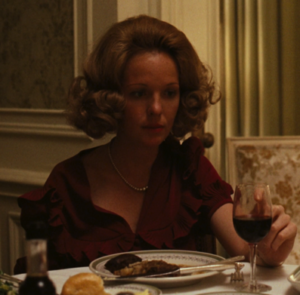 We end with a shot of Kay staring at her wine glass. The camera once again positions us at a medium close-up, reinforcing her pain and hesitation. We know Sollozzo’s attack has unnerved Michael. We might foresee his looming retaliation. Perhaps we even correctly infer his ultimate fate from these character developments. But empathizing with Kay’s pain, we question if her relationship with Michael will last.
We end with a shot of Kay staring at her wine glass. The camera once again positions us at a medium close-up, reinforcing her pain and hesitation. We know Sollozzo’s attack has unnerved Michael. We might foresee his looming retaliation. Perhaps we even correctly infer his ultimate fate from these character developments. But empathizing with Kay’s pain, we question if her relationship with Michael will last.